New Mexico has a vibrant and complete fossil record. Approximately 3,300 different types of fossils have been discovered in the state, which dates back more than 500 million years and encompasses the majority of the Paleozoic, Mesozoic, and Cenozoic eras. A warm, shallow sea submerged the state during the early Paleozoic. Numerous sea creatures like trilobites, graptolites, cartilaginous fish, corals, bryozoans, and brachiopods inhabit the sea.
New Mexico had a relatively dry climate during the Jurassic. Dinosaurs such as Stegosaurus, Allosaurus, and the long-necked sauropods thrived through this period. Cooler temperatures eventually ushered in the Ice Age, when the state provided habitat for the incredible mastodons.
Read on for more information about the 8 extinct animals in New Mexico.
8 Extinct Animals That Lived in New Mexico
Many mammalian megafauna and prehistoric reptiles have been discovered throughout New Mexico. The following are some of the most critical fossils found in New Mexico, ranging from the official state fossil, Coelophysis bauri, to the vast prehistoric bird Gastornis.
1. The Giant Bison
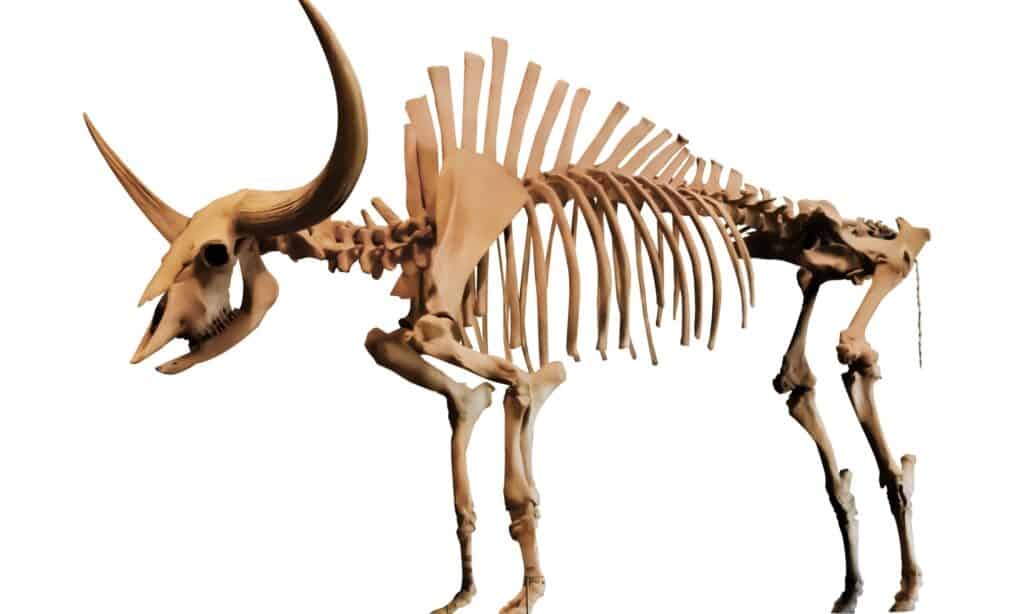
The giant bison became extinct about 20,000–30,000 years ago at the beginning of the last glacial maximum.
©iStock.com/barbaraaaa
| The Giant Bison | |
|---|---|
| Kingdom | Animalia |
| Phylum | Chordata |
| Class | Mammalia |
| Order | Artiodactyla |
| Family | Bovidae |
| Subfamily | Bovinae |
| Genus | Bison |
| Species | Bison latifrons |
| Living period | About 200,000 years to 30,000 years ago |
The giant bison (Bison latifrons) were an extinct species of bison that lived in North America for about 200,000 years. It was one of the largest bovids, which measured approximately 15.6 feet in length and stood about 8.2 feet tall at the withers, with an estimated weight of between 2,760 and 4,400 pounds. It’s believed that the giant bison lived in small herds, grazing in the Great Plains and browsing in the woodlands of North America. They had thick horns to protect themselves from carnivorous megafaunas like the giant short-faced bear and saber-toothed cat.
The giant bison became extinct about 20,000–30,000 years ago at the beginning of the last glacial maximum. Archeologists have discovered giant bison remains associated with the Native American settlements in New Mexico. The Native Americans and the European colonists hunted giant bison to extinction. This is also ironic since the inhabitants worshipped the giant bison as a natural demigod.
2. Gastornis
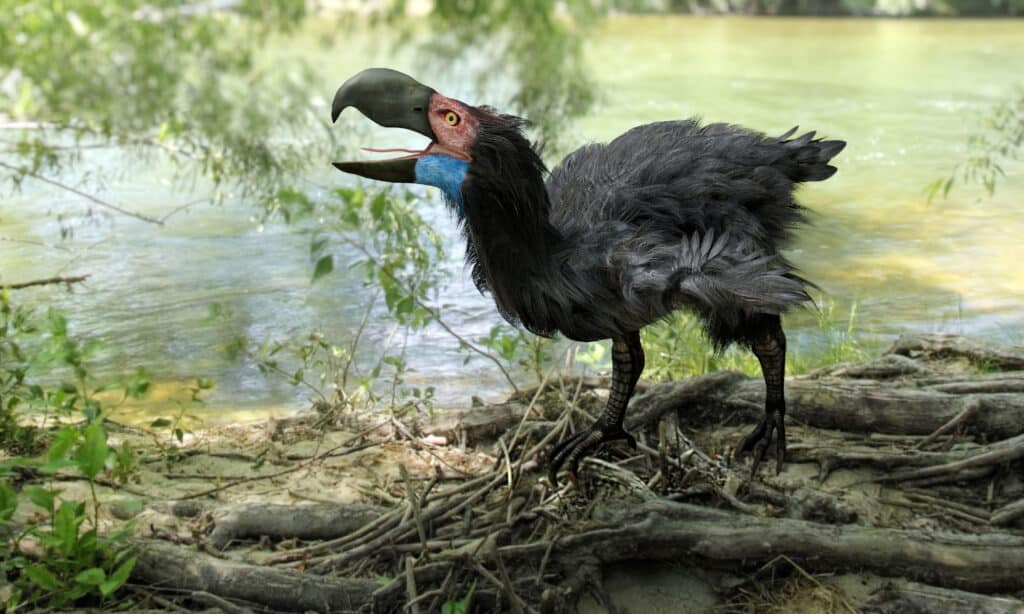
Gastornis is an extinct large flightless bird that lived from the mid-Paleocene to mid-Eocene epochs.
©iStock.com/Aunt_Spray
| Gastornis | |
|---|---|
| Kingdom | Animalia |
| Phylum | Chordata |
| Class | Aves |
| Order | Gastornithiformes |
| Family | Gastornithidae |
| Genus | Gastornis |
| Living period | mid-Paleocene to mid-Eocene epochs |
Gastornis is an extinct large flightless bird that lived from the mid-Paleocene to mid-Eocene epochs, about 55 to 45 million years ago. Although it wasn’t the biggest prehistoric bird that ever lived (this honor belongs to the elephant bird), Gastornis was one of the most dangerous, with massive skulls and huge beaks that closely resembled the predatory South American “terror birds” (phorusrhacids). Its skull was more extensive than its body and also powerfully built. Based on the fossil remains, Gastornis could grow to the size of the largest moa, approximately 6 feet tall.
The American paleontologist Edward Drinker Cope discovered a fragmented set of Gastornis fossils in 1874 in the Wasatch Formation of New Mexico. The reason why Gastornis became extinct remains unknown. While some scientists speculate that their extinction had something to do with climate change, others believe that Gastornis went extinct due to increased food and habitat competition with other mammals.
3. Coryphodon

Coryphodon had short lower limbs and long upper limbs that facilitated movement.
©Charles R. Knight / public domain – License
| Coryphodon | |
|---|---|
| Kingdom | Animalia |
| Phylum | Chordata |
| Class | Mammalia |
| Order | Cimolesta |
| Family | Coryphodontidae |
| Genus | Coryphodon |
| Living period | Late Paleocene and Early Eocene |
Coryphodon is an extinct member of the world’s first group of large browsing mammals. This species became extinct about 38-40 million years ago. It grew to 8.2 feet in total body length and about 3.3 feet at shoulder height. Based on a regression analysis of ungulates, Coryphodons weighed approximately 750 to 1,300 pounds, with some large specimens weighing as much as 1,500 pounds.
Coryphodon had short lower limbs and long upper limbs that facilitated movement. It had one of the smallest brains, weighing just 3.2 oz (90 grams). Numerous Coryphodon fossils have been discovered throughout New Mexico. This large-bodied, plant-eating mammal enjoyed the state’s much lusher and humid climate millions of years ago.
4. Pachycephalosaurus

Pachycephalosaurus was bipedal and probably the largest of the bone-headed dinosaurs.
©Daniel Eskridge/Shutterstock.com
| Pachycephalosaurus | |
|---|---|
| Kingdom | Animalia |
| Phylum | Chordata |
| Class | Dinosauria |
| Order | Ornitischia |
| Suborder | Pachycephalosauria |
| Family | Pachycephalosauridae |
| Genus | Pachycephalosaurus |
| Living period | Late Cretaceous period- 100 million to 65.5 million years ago |
Pachycephalosaurus, meaning “thick-headed lizard,” is a giant herbivorous dinosaur that lived during the Late Cretaceous period. It possessed a thicker-than-usual skull, which males used to head-butt each other to gain dominance in the herd. These creatures also used their skulls to protect themselves from predators.
Pachycephalosaurus was bipedal and probably the largest of the bone-headed dinosaurs. They had heavy tails, long hind legs, short forelimbs, thick necks, and bulky bodies. It’s assumed that this creature survived on a mixed fruit, seed, and leaf diet.
More complete Pachycephalosaurus fossils have been found in recent years. New Mexico at least provided habitat for two important Pachycephalosaurus genera— Sphaerotholus and Stegoceras.
5. Coelophysis bauri
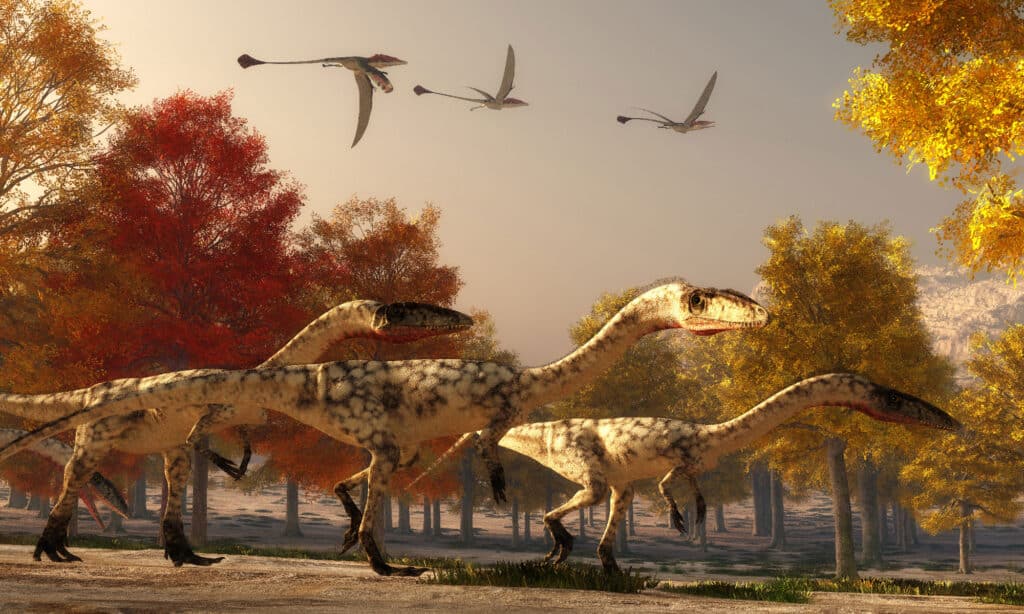
Coelophysis bauri was a carnivorous, bipedal, and agile runner.
©Catmando/Shutterstock.com
| Coelophysis bauri | |
|---|---|
| Kingdom | Animalia |
| Phylum | Chordata |
| Clade | Dinosauria |
| Clade | Saurischia |
| Clade | Theropoda |
| Family | Coelophysidae |
| Genus | Coelophysis |
| Living period | Mid-Triassic Period- 228 to 200 million years ago |
Coelophysis bauri is the official state fossil of New Mexico. It was a small, slenderly-built, ground-dwelling theropod dinosaur that could grow up to 9.8 feet long and weighed between 33 and 55 pounds. Numerous Coelophysis remains have been excavated at the Ghost Ranch quarry.
Coelophysis bauri was a carnivorous, bipedal, and agile runner. Its tail and neck were long and slender, while its hips and feet were narrow. It had a thin head with forward-facing eyes that afforded excellent depth perception. Its teeth were blade-like, recurved, sharp, and jagged, with exceptional serrations on the anterior and posterior edges, probably an adaptation for feeding. Coelophysis lived approximately 228 to 200 million years ago during the Mid-Triassic Period.
6. Parasaurolophus
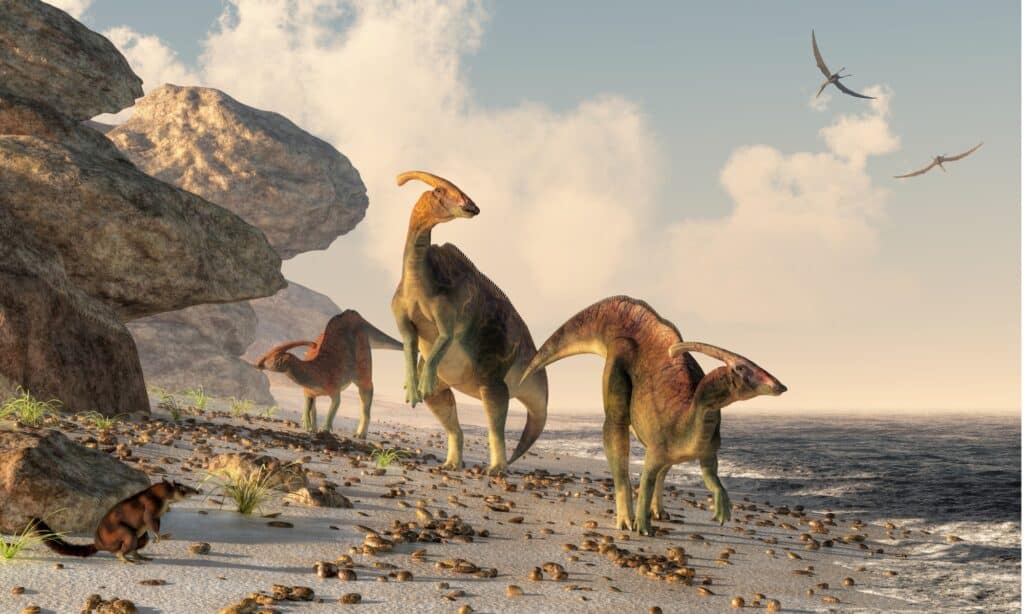
Parasaurolophus fossils were first discovered in Canada in 1922.
©iStock.com/Daniel Eskridge
| Parasaurolophus | |
|---|---|
| Kingdom | Animalia |
| Phylum | Chordata |
| Clade | Dinosauria |
| Clade | Ornithopoda |
| Order | Ornitischia |
| Family | Hadrosauridae |
| Subfamily | Lambeosaurinae |
| Genus | Parasaurolophus |
| Living period | Late Cretaceous Period (76 to 74 million years ago) |
Parasaurolophus is an extinct herbivorous dinosaur that lived about 76 to 74 million years ago during the Late Cretaceous Period. This creature had a distinctive crest that most paleontologists believe contained tubes connected to its nostrils. This way, Parasaurolophus was able to honk messages to other members of the herd.
Some dinosaur scientists believe that the crest may have been a sexually selected characteristic; males with huge crests might have been more attractive to females during the mating season. It’s estimated that Parasaurolophus grew up to 31 feet long and weighed approximately 5,600 pounds.
Parasaurolophus fossils were first discovered in Canada in 1922. In 1961, bones of the Parasaurolophus were found during subsequent excavations in New Mexico at the Fruitland Formation. Along with other herbivorous dinosaurs, it’s believed that Parasaurolophus lost its food source and slowly died off.
7. Nothronychus
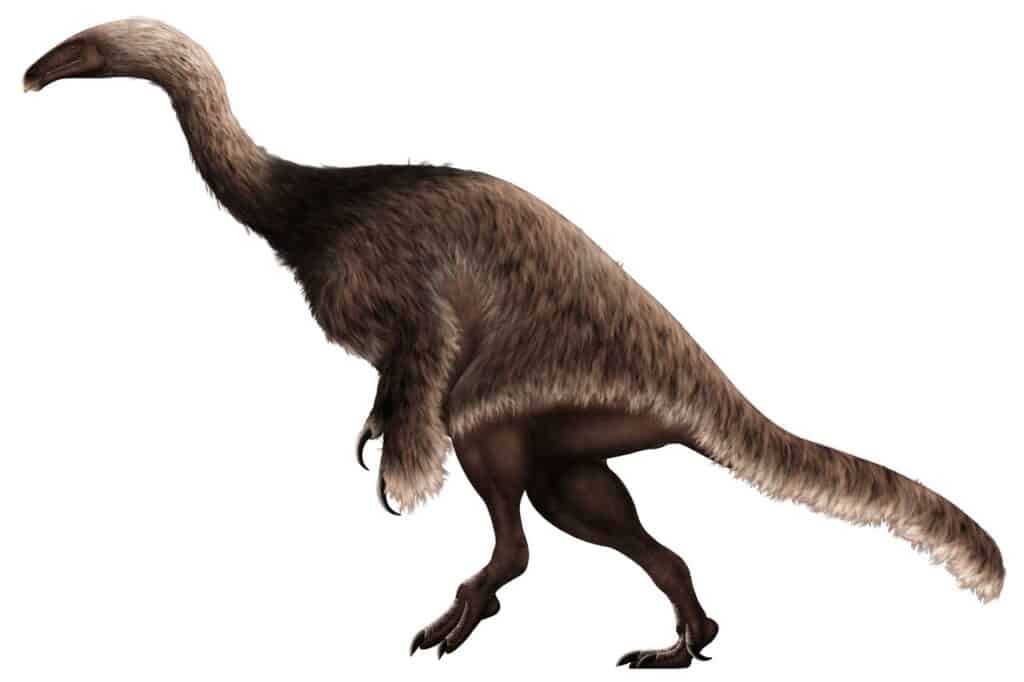
Nothronychus had prominent arms, sharp claws, four-toed feet facing forward, and a wide, sloth-like hip.
©PaleoNeolitic / CC BY 4.0 – License
| Nothronychus | |
|---|---|
| Kingdom | Animalia |
| Phylum | Chordata |
| Clade | Dinosauria |
| Clade | Saurischia |
| Clade | Theropoda |
| Family | Therizinosauridae |
| Genus | Nothronychus |
| Living period | Late Cretaceous Period |
Nothronychus was a long-necked, long-clawed, and pot-bellied theropod dinosaur that inhabited North America during the Late Cretaceous Period. It had prominent arms, sharp claws, four-toed feet facing forward, and a wide, sloth-like hip. Like its relatives, Nothronynchus was a plant-eating dinosaur. Based on fossil analysis, this species could grow to a height of up to 14 feet and weigh approximately 1,800 pounds.
The first Nothronychus fossils were discovered by a group of paleontologists working in the Zuni Basin of New Mexico at the Moreno Hill Formation. It is assumed that Nothronychus became extinct about 89 million years ago.
8. Diplodocus
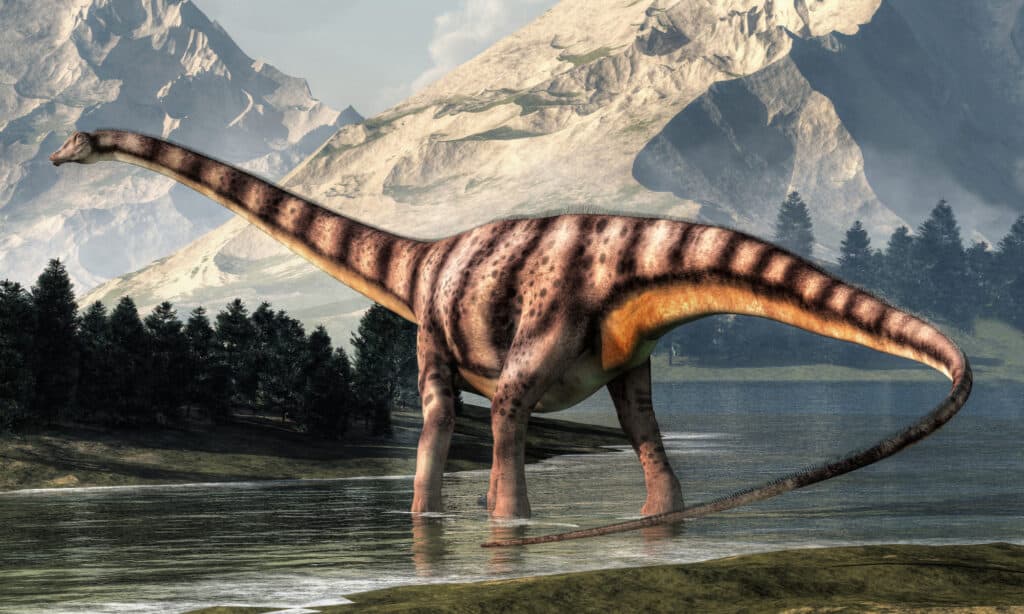
Diplodocus are Sauropods, a group of large, long-necked quadrupedal dinosaurs with long, whip-like tails.
©Daniel Eskridge/Shutterstock.com
| Diplodocus | |
|---|---|
| Kingdom | Animalia |
| Phylum | Chordata |
| Clade | Dinosauria |
| Clade | Saurischia |
| Clade | Sauropodomorpha |
| Clade | Sauropoda |
| Superfamily | Diplodocoidea |
| Family | Diplodocidae |
| Subfamily | Diplodocinae |
| Genus | Diplodocus |
| Living period | Late Jurassic Period |
Of all the dinosaurs, Diplodocus was the most easily recognized. It’s also one of the most referenced dinosaurs in numerous movies and music.
Diplodocus are Sauropods, a group of large, long-necked quadrupedal dinosaurs with long, whip-like tails. Total length estimates range from 95-105 feet. It’s also estimated that this creature could have weighed up to 250,000 pounds (125 tons). Diplodocus became extinct during the late Jurassic period, about 152 million to 146 million years ago.
The first Diplodocus fossils were discovered in the Morrison Formation in 1877. Since then, numerous remains have been unearthed throughout the United States, including the 30-ton sauropod skeleton excavated in New Mexico and named after the Ojo Alamo Formation, a geological formation in New Mexico.
The photo featured at the top of this post is © Daniel Eskridge/Shutterstock.com
Thank you for reading! Have some feedback for us? Contact the AZ Animals editorial team.






